
95% of researchers rate our articles as excellent or good
Learn more about the work of our research integrity team to safeguard the quality of each article we publish.
Find out more
ORIGINAL RESEARCH article
Front. Vet. Sci. , 11 April 2023
Sec. Parasitology
Volume 10 - 2023 | https://doi.org/10.3389/fvets.2023.1156834
 Gregorio Gonzalez-Alcaide1†
Gregorio Gonzalez-Alcaide1† Nestor Sosa2†
Nestor Sosa2† Laura Shevy2†
Laura Shevy2† Isabel Belinchon-Romero3†
Isabel Belinchon-Romero3† Jose-Manuel Ramos-Rincon3*†
Jose-Manuel Ramos-Rincon3*†Background: Cysticercosis is a parasitic infection caused by the larval stage Taenia solium. As a neglected tropical disease that is also difficult to diagnose, cysticercosis constitutes an important public health and research challenge. To characterize the development of research on cysticercosis and neurocysticercosis, considering the level of scientific evidence provided and the contribution of different countries to research, according to their endemic nature and their income level.
Methods: Indexed publications on cysticercosis and neurocysticercosis were retrieved from the MEDLINE database, and the evolution of scientific production and the topic areas addressed in the body of research were analyzed.
Results: A total of 7,860 papers published between 1928 and 2021 were analyzed. The volume of annual publications increased over time, standing at over 200 documents/year since 2010. Case studies constitute the main study design (27.4% of the documents with available information, n = 2,155), with fewer studies that provide the highest levels of scientific evidence, such as clinical studies (1.9%, n = 149) or systematic reviews (0.8%, n = 63). The most productive journals belong to the Parasitology and Tropical Medicine categories. Although the USA is the most productive country (n = 2,292), countries where Tenia solium is endemic, such as India (n = 1,749), Brazil (n = 941) and Peru (n = 898) also stand out, as does Mexico (n = 1,414). However, other endemic countries in Latin America and sub-Saharan Africa show little participation in the research. The level of international collaboration by country is very uneven, with some countries presenting very low values, such as India (9.9% of documents in international collaboration) or Brazil (18.7%); while there is evidence of intense international collaboration in countries like Peru (91.3%), Tanzania (88.2%) or Kenya (93.1%). Research output has coalesced in three thematic clusters: basic research in animals; parasitism, animal health, and zoonoses; and the diagnosis and therapeutic approach in diseases associated with cysticercosis and neurocysticercosis.
Conclusions: The generation of knowledge on cysticercosis presents different features from other areas of research, such as the outstanding contribution of only some endemic countries; and the relevance of comprehensive approaches to research (animal and human health). Studies that provide higher levels of scientific evidence should be promoted, as should research in endemic areas.
Neglected tropical diseases (NTDs) are a heterogeneous group, defined by their prevalent nature in tropical or subtropical areas and their disproportional impact on impoverished communities, for which they impose a significant human, social and economic burden (1–3).
NTDs mainly comprise parasitic infections, such as Chagas disease, dracunculiasis, echinococcosis, trypanosomiasis, leishmaniasis, lymphatic filariasis, onchocerciasis, or taeniasis/cysticercosis. These diseases pose a major challenge due to their endemic nature in countries with relatively underdeveloped health systems and limited scientific capacity. Thus, research must prioritize the burdens and healthcare needs associated with the disease, which frequently encompass its proper diagnosis and assured treatment for the affected populations (4, 5).
Cysticercosis is caused by the larval stage of cestode T. solium. It is acquired by the ingestion of T. solium eggs, shed in the stool of a human tapeworm carrier. Following ingestion, embryos (oncospheres) hatch in the small intestine, invade the bowel wall, and disseminate hematogenously to brain (neurocysticercosis, causing different neurological symptoms like “epilepsy”) “striated muscles,” “liver,” and/or other tissues.
Neurocysticercosis is endemic to much of Asia, sub-Saharan Africa, and Latin America, where it constitutes a prominent public health problem associated with poverty and poor sanitary and hygienic conditions (6). Its prevalence is probably underestimated due both to the difficulty in diagnosing it (since it often produces mild and non-specific symptoms) and the lack of observational studies in different populations and countries (7). The estimated burden of human cysticercosis, according to systematic reviews or similar studies published from 2010 to 2015, is 2.78 million disability-adjusted life years (DALYs) (95% uncertainty intervals 2.14-3.61 million) (8). Neurocysticercosis is responsible for 30% to 70% of epilepsies in some endemic countries and regions (9, 10).
The literature contains extensive bibliometric analyses of NTDs such as leishmaniasis, Chagas, schistosomiasis, trypanosomiasis, and echinococcosis, among others, including some papers that focus on specific regions or countries such as Nigeria and India (11–15). However, no publications are available that analyze the scientific production on cysticercosis/neurocysticercosis.
The objective of this study is to describe the research on cysticercosis and neurocysticercosis, analyzing the evolution of scientific production, the distribution of contributions from different countries based on the endemicity of the disease and income level of the country, the relevance of international collaboration, and the defining features that characterize research on this NTD at the thematic and methodological level.
The MEDLINE database was used to carry out the analysis since it has the Medical Subject Headings (MeSH) thesaurus that allows very precise searches and because it is the most widely used source of information in the field of health sciences (mainly, English).
To identify the body of documents under study, two search processes were combined: the documents indexed using the MeSH term “Cysticercosis;” and a search with free-text terms.
The MeSH thesaurus defines cysticercosis as “Infection with CYSTICERCUS, the larval form of the various tapeworms of the genus Taenia (usually T. solium in man). In humans, they penetrate the intestinal wall and invade subcutaneous tissue, brain, eye, muscle, heart, liver, lung, and peritoneum. Brain involvement results in NEUROCYSTICERCOSIS.” This last term has also been included in the MeSH since 1999 as a specific descriptor for cysticercosis, so by using the “explode” function, all the documents tagged with the neurocysticercosis descriptor were identified to characterize their content. The MeSH defines neurocysticercosis as “Infection of the brain, spinal cord, or perimeningeal structures with the larval forms of the genus Taenia“ (primarily T. solium in humans). Lesions formed by the organism are known as cysticerci. The infection may be subacute or chronic, and the severity of symptoms depends on the severity of the host immune response and the location and number of lesions. Seizures represent the most common clinical manifestation, although focal neurologic deficits may occur.
Likewise, two search strings were developed that consider all the possible synonyms of the terms “cysticercosis” and “neurocysticercosis” collected in the MeSH that could have been used in the title and abstract of the documents indexed in the MEDLINE database:
Cysticercosis[Title/Abstract] OR Cysticercoses[Title/Abstract] OR “Coenuri Infection*”[Title/Abstract] OR Coenurosis[Title/Abstract] OR Coenuroses[Title/Abstract] OR “Coenurus cerebralis Infection*”[Title/Abstract] OR “Cysticercus cellulosae Infection*”[Title/Abstract] OR “T. solium Cysticercosis”[Title/Abstract] OR “T. solium Cysticercoses”[Title/Abstract].
Neurocysticercosis[Title/Abstract] OR Neurocysticercoses[Title/Abstract] OR Neurocoenurosis[Title/Abstract] OR Neurocoenuroses[Title/Abstract] OR “Central Nervous System Cysticercosis”[Title/Abstract] OR “CNS Cysticercosis”[Title/Abstract] OR “CNS Cysticercoses”[Title/Abstract] OR “Brain Cysticercosis”[Title/Abstract] OR “Cerebral Coenurosis”[Title/Abstract] OR “Cerebral Coenuroses”[Title/Abstract] OR “Cerebral Cysticercosis”[Title/Abstract] OR “Cerebral Cysticercoses”[Title/Abstract].
The use of a thesaurus offers great consistency with regard to the precise identification of the relevant literature in relation to the topic under study, while using free-text terms favors the exhaustiveness of the searches, correcting possible gaps in the allocation processes of the MeSH terminology and, above all, making it possible to identify the most recent literature that has not yet been assigned descriptors. The MeSH thesaurus includes the term coenurosis as a synonym for cysticercosis and the terms neurocoenurosis/cerebral coenurosis as a synonym for neurocysticercosis. For this reason, both terms have been included in the search process. However, under current understanding among global parasitologists, cysticercus/cysticercosis is used for the larval stage of T. solium, coenurus/coenurosis is used for the larval stage of T. multiceps and T. serialis.
The searches were carried out in October 2022.
Bibliographic information from the identified documents was downloaded to review and standardize the data for their subsequent quantitative analysis. In this sense, the duplicated information from some fields (such as the MeSH descriptors) was individualized. The following processes were performed.
In addition to the formal classification of documents used widely by scientific journals (articles, reviews, and letters), the document categories identified in MEDLINE that are relevant from the clinical or epidemiological point of view were identified based on the research methodology used and the level of scientific evidence provided: case reports, clinical studies (controlled clinical trials/randomized controlled trials), observational studies, comparative studies, evaluation studies, guidelines/practice guidelines, systematic reviews, meta-analyses, and validation studies. Some documents were not assigned to any category, while others were assigned to more than one.
The frequency of the MeSH terms assigned to the documents was determined, and a map of thematic clusters was generated, in order to obtain a visual overview of the thematic groupings comprising the body of research and the interrelationships established between the descriptors. For this purpose, a matrix was generated, quantifying how frequently the MeSH terms appeared together on the documents, and VOSViewer clustering algorithm was applied (https://www.vosviewer.com). Results are presented visually with VoSViewer. The clusters were labeled with concepts that broadly described the topic area of the MeSH terms included under each. The analysis was performed on 91.1% (n = 7,161) of the identified records that were assigned with the “cysticercosis” or “neurocysticercosis” descriptor.
For the analysis of the scientific output by country and the international collaboration, we used the documents identified in MEDLINE that were also collected in the Web of Science-Core Collection (WoS-CC), since this database includes information on institutional affiliations throughout the entire period analyzed, something that MEDLINE has only done systematically since 2014. Altogether, 68.8% (n = 5,411) of the documents analyzed are included in the WoS-CC, although in recent years around 85% to 90% are included. In addition to individualizing the instances with more than one institution to determine the different types of collaboration (domestic and international), the documents assigned to England, Scotland, Wales, and Northern Ireland were unified into the United Kingdom (UK). Domestic collaboration was defined as documents with authors from two or more institutions, administrative units, or departments of an institution from the same country. Authors from two or more institutions from different countries indicated international collaboration. In the case of documents with international collaboration, we also analyzed the country of the first author and corresponding author, roles that can be associated with research leadership, that is, a more relevant contribution to the conception, promotion, and responsibility for the studies carried out.
Records were also analyzed in terms of the endemicity of T. solium in the countries appearing in the institutional affiliations. Endemicity was determined using information from the World Health Organization (WHO) for 2022 (https://www.who.int/data/gho/data/indicators/indicator-details/GHO/status-of-endemicity-of-taenia-solium):
- Endemic countries;
- Suspected endemic;
- Few pigs with risk factors;
- Possible transmission in some communities;
- Non-endemic.
Scientific output was assessed according to the countries' economic development, as estimated from the gross national income (GNI) per capita, PPP (current international $), for 2021, using data provided by the International Comparison Program of the World Bank (https://data.worldbank.org/indicator/NY.GNP.PCAP.PP.CD), which classifies countries into:
- Low income;
- Lower middle income;
- Upper middle income;
- High income.
Once these processes were carried out, the following indicators were calculated:
- N documents per year of publication;
- N documents by document type and study design;
- N documents per journal;
- N documents per country.
- N documents in domestic collaboration;
- N documents in international collaboration;
- N documents as first signatories;
- N documents as corresponding authors.
- Frequency of the MeSH terms assigned to the documents. The following categories were specifically identified and analyzed: humans/animals; qualifiers; diagnostic processes and techniques; and age groups;
- Research clusters, as generated based on the rest of descriptors.
In the MeSH search, the term “cysticercosis” and/or “neurocysticercosis” was assigned to 6,448 documents between 1928 (oldest reference identified) and 2021, while the free text search yielded another 1,499 records, a total 7,947 documents. The terms coenurosis and/or neurocoenurosis/cerebral coenurosis are present in the title of 104 documents and the abstract of 96 documents (in total 148 different documents, only 1.88% of the total number of documents analyzed). Eighty-seven records were excluded: 49 editorials and 38 other document types. The final analysis included only 7,860 articles, reviews, and letters—the document types commonly used in bibliometric studies because of their relevance for research and their reporting of original knowledge.
The main document type was journal article (n = 6,474; 82.4%), followed by review (n = 873, 11.1%) and letter (n = 513; 6.5%) (Table 1). Figure 1 shows the annual number of publications, which follows a linear growth trend (R2 = 0.92). Fewer than 20 documents were published annually from 1928 to 1948, 20 to 49 documents from 1950 to 1969, 50 to 99 from 1970 to 1987, 100 to 200 from 1988 to 1999, and more than 200 documents from 2010 to 2021.
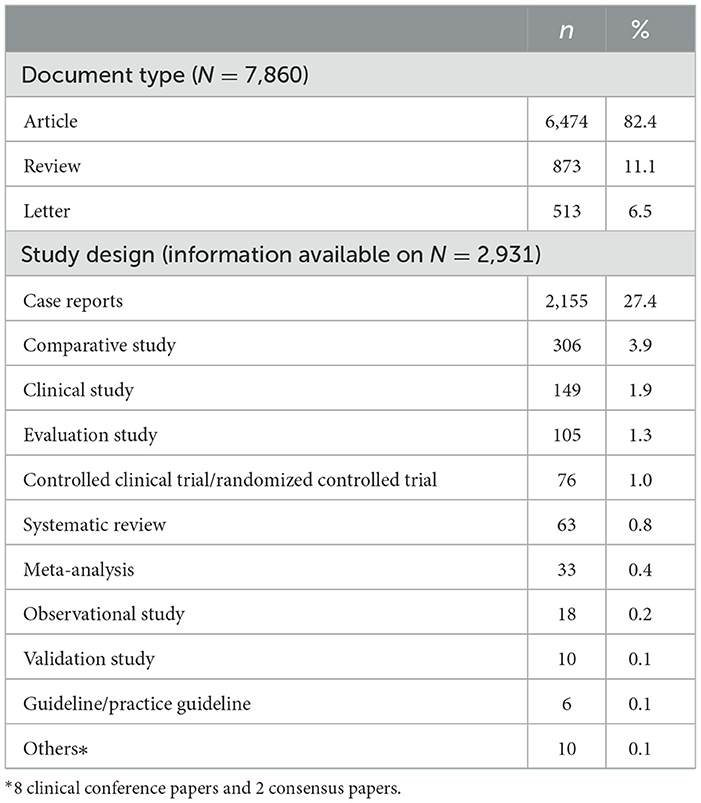
Table 1. Publications on cysticercosis and neurocysticercosis indexed in the MEDLINE database, according to document type and study design.

Figure 1. Evolution of the annual number of documents published on cysticercosis and neurocysticercosis and included in the MEDLINE database.
There were 2,931 documents (37.3% of the total) with specific information available on the study design or type of evidence provided. Case reports were the most common type of study (n = 2,155, 27.4%), whereas papers presenting the highest levels of scientific evidence, such as clinical studies (1.9%, n = 149) or systematic reviews (0.8%, n = 63), were quite sparse, and the presence of clinical practice guidelines was anecdotal (0.1%, n = 6).
The 7,860 papers about cysticercosis were published in 1,554 journals. There were 23 journals (1.5%) that published more than 49 papers; together, these journals were responsible for 25.6% of the total records. Another 767 journals (49.4%) published a single document on the topic. The leading journals were Arquivos de Neuro-Psiquiatria (the official journal of the Brazilian Academy of Neurology) and the American Journal of Tropical Medicine and Hygiene (the official journal of the American Society of Tropical Medicine and Hygiene); each published 188 documents (2.4%). Veterinary Parasitology (the official organ of the American Association of Veterinary Parasitologists, the European Veterinary Parasitology College, and the World Association for the Advancement of Veterinary Parasitology) also stood out with 148 documents (1.9%) (Table 2).
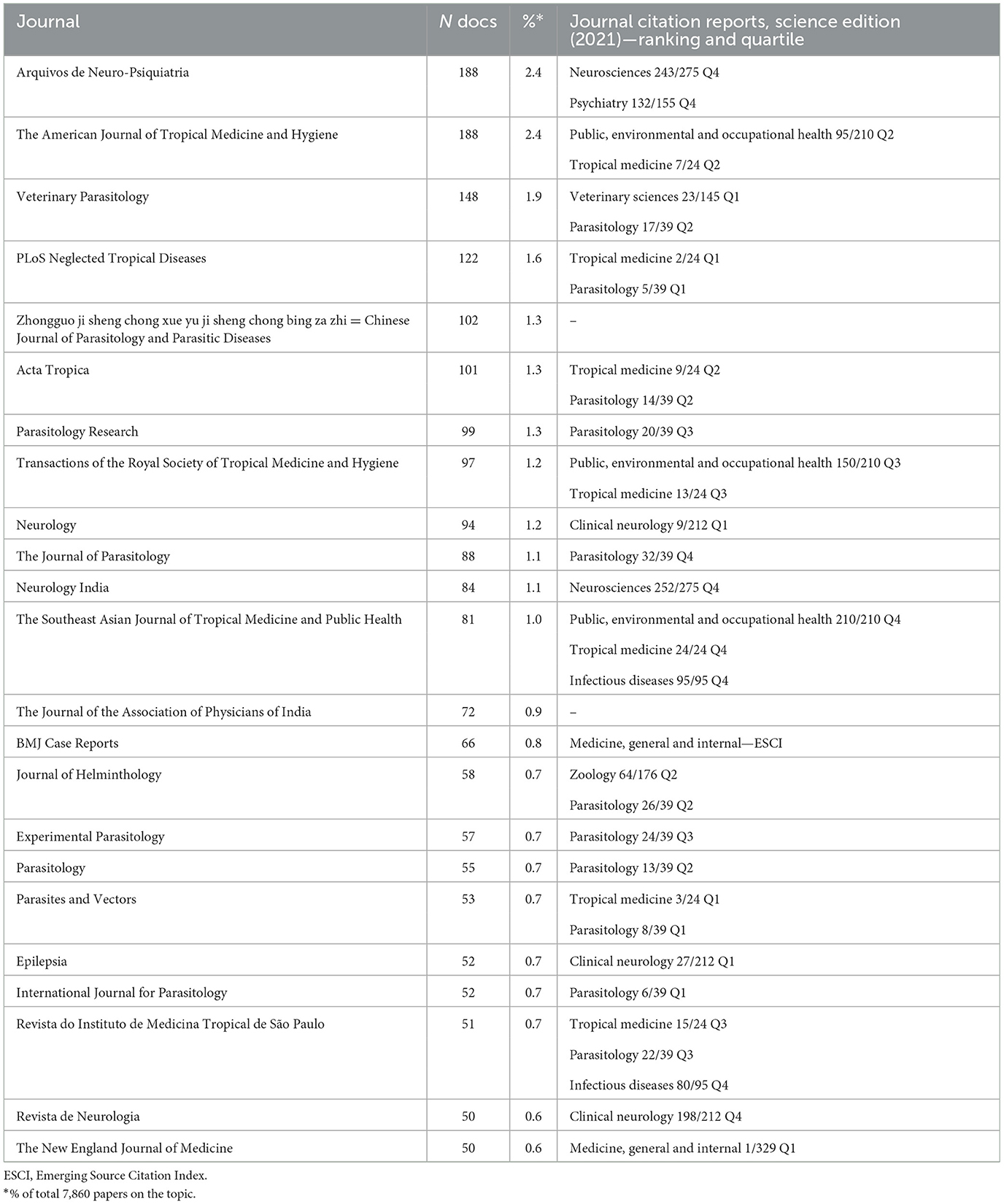
Table 2. Top journals publishing papers on cysticercosis and neurocysticercosis and indexed in MEDLINE.
The most productive journals included 7 high-impact journals (Q1 according to the journal impact factor ranking in the 2021 edition of Journal Citation Reports, JCR), along with various others with less visibility (4 journals in Q2, 4 journals in Q3, 5 journals in Q4 and one journal as a candidate in the Emerging Source Citation Index). Only two of the most productive journals (Chinese Journal of Parasitology and Parasitic Diseases and The Journal of the Association of Physicians of India) are not included in the JCR.
Of the countries represented in the authors' institutional affiliations, 46.4% were non-endemic and 40.7%, endemic. The proportion of contributions by researchers from endemic countries increased from 39% in 1980–2000 to 69.4% in 2001–2021. In terms of economic development as measured using the GNI, authors in high-income countries participated in 47.7% of the documents, well ahead of participation by authors in upper middle-income (29.6%), lower middle-income (19.6%), and low-income countries (2.6%), even though endemic countries are concentrated in these latter categories (Table 3). Figure 2 shows research activity in endemic countries and Supplementary Annex I contains the complete list of scientific activity in endemic countries and countries where transmission is suspected.
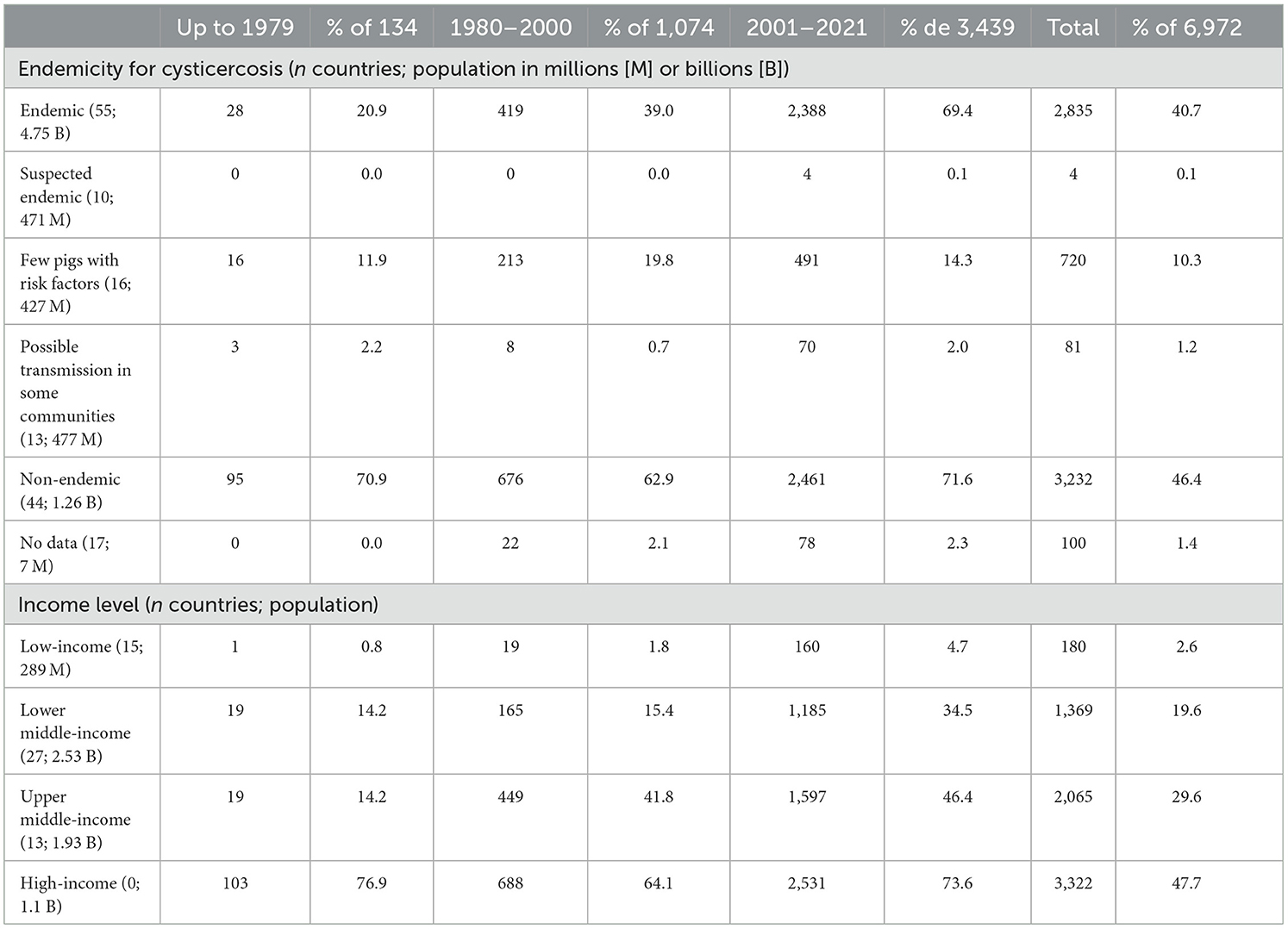
Table 3. Participation in research on cysticercosis and neurocysticercosis by country, according to endemicity and income level (N = 6,972 publications included in the Web of Science Core Collection).
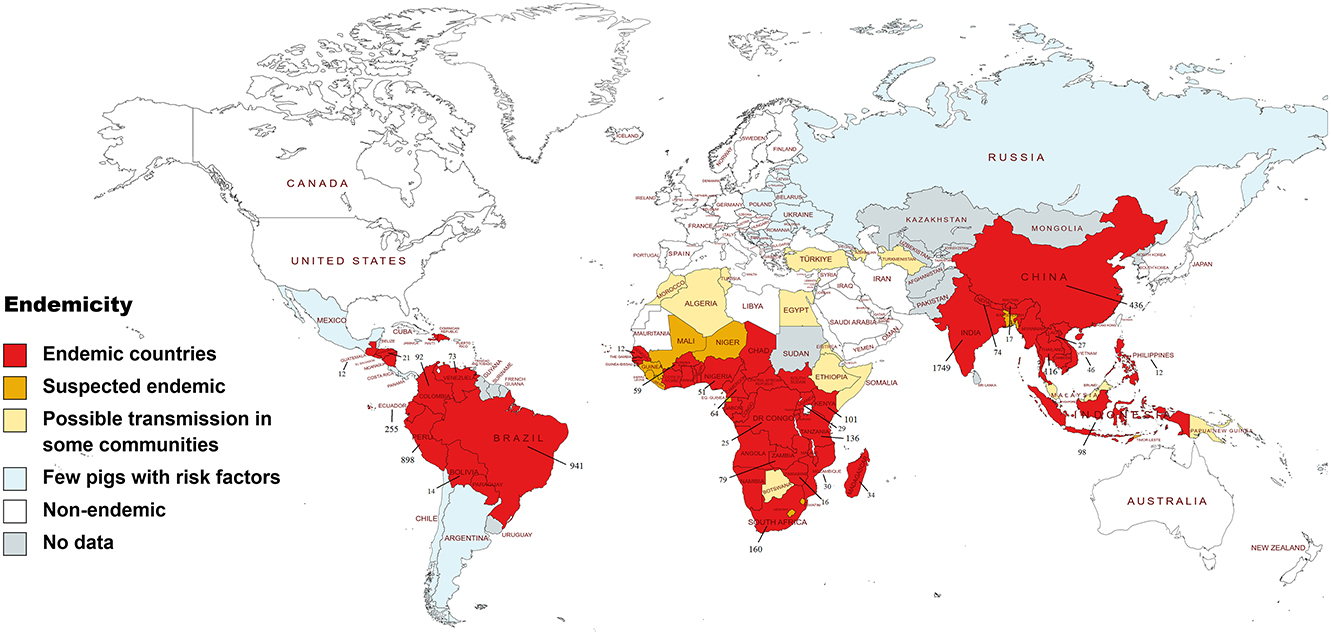
Figure 2. Research on cysticercosis and neurocysticercosis from countries where T. solium is endemic included in the MEDLINE database (> 10 papers).
In the analysis of scientific production by country, the most significant finding is that the highest production levels (>100 documents) were shared by countries endemic for T. solium along with some countries with the highest scientific development. Thus, after the USA (n = 2,292 documents), research output was highest in India (n = 1,749), Mexico (n = 1,414, non-endemic country, but classified as having “few pigs with risk factors”), Brazil (n = 941) and Peru (n = 898). Next, research was carried out in different countries in Europe and Asia (China, Japan, and South Korea), along with Australia, Canada, and other endemic countries such as Ecuador, Tanzania, Thailand, and Kenya (Table 4).
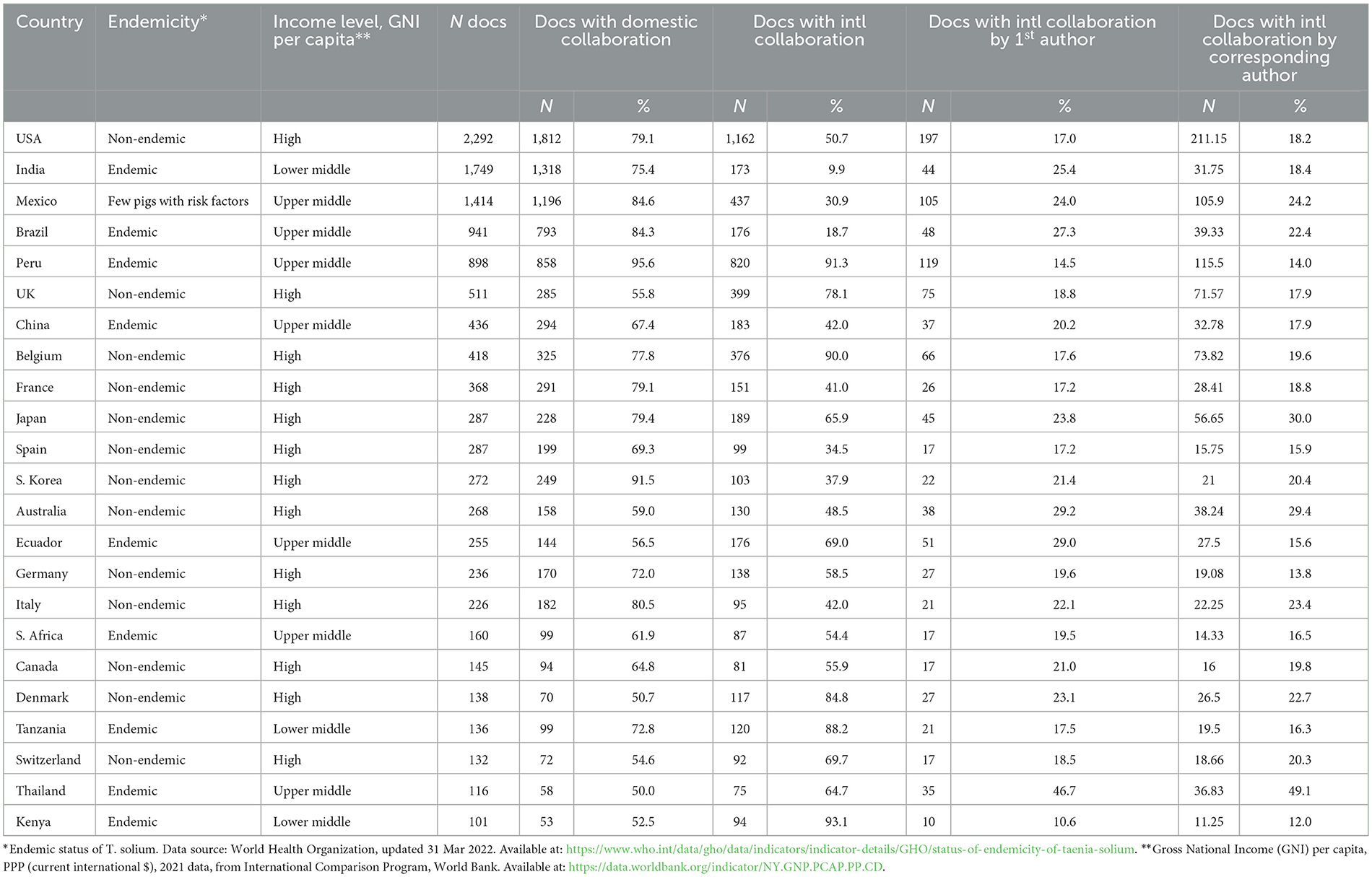
Table 4. Research production, collaboration, and leadership by country of institutional affiliations, in documents published on cysticercosis and neurocysticercosis and included in the Web of Science Core Collection.
The manuscripts where there are authors from two or more institutions from different countries was considered an international collaboration (information available in 4,642 documents). Globally, 28.6% (n = 1,330) of the documents analyzed were produced in international collaboration. Collaboration increased throughout the study period, from 5.2% of the documents (n = 7) published before 1980, to 17.7% (n = 190) in 1980–2000, to 32.9% in 2001–2021.
In the case of documents with international collaboration, we also analyzed the country of the first author and corresponding author (information available in 4,642 documents), roles that can be associated with research leadership, that is, a more relevant contribution to the conception, promotion, and responsibility for the studies carried out The level of international collaboration varied widely by country, with some countries presenting very low values, such as India (9.9% of documents in international collaboration) or Brazil (18.7%); and others displaying high levels of collaboration, such as Peru (91.3%), Tanzania (88.2%), or Kenya (93.1%). However, this high international collaboration contrasts with their low levels of research leadership, with limited participation as first or corresponding authors (Table 4).
In relation to the thematic areas, research in animals shares the spotlight with research in humans, with both spheres coinciding more and more (Table 5). Overall, 46.9% of the documents (n = 3,690) are focused exclusively on research in humans compared to 16.8% in animals, although the documents assigned with both descriptors rose from 24.1% (n = 570) in 1980–2000 to 32.8% (n = 1,400) in 2001–2021.

Table 5. Documents on cysticercosis and neurocysticercosis assigned MeSH descriptors for research in humans and animals and indexed in MEDLINE.
“Diagnosis” (n = 2,299) is the main qualifier assigned to the descriptors cysticercosis and neurocysticercosis, followed by “epidemiology” (n = 1,133), “complications” (n = 1,125) and “drug therapy” (n = 1,043). “Parasitology” (n = 1,019) and “veterinary” (n = 930) also have a notable presence (Table 6).
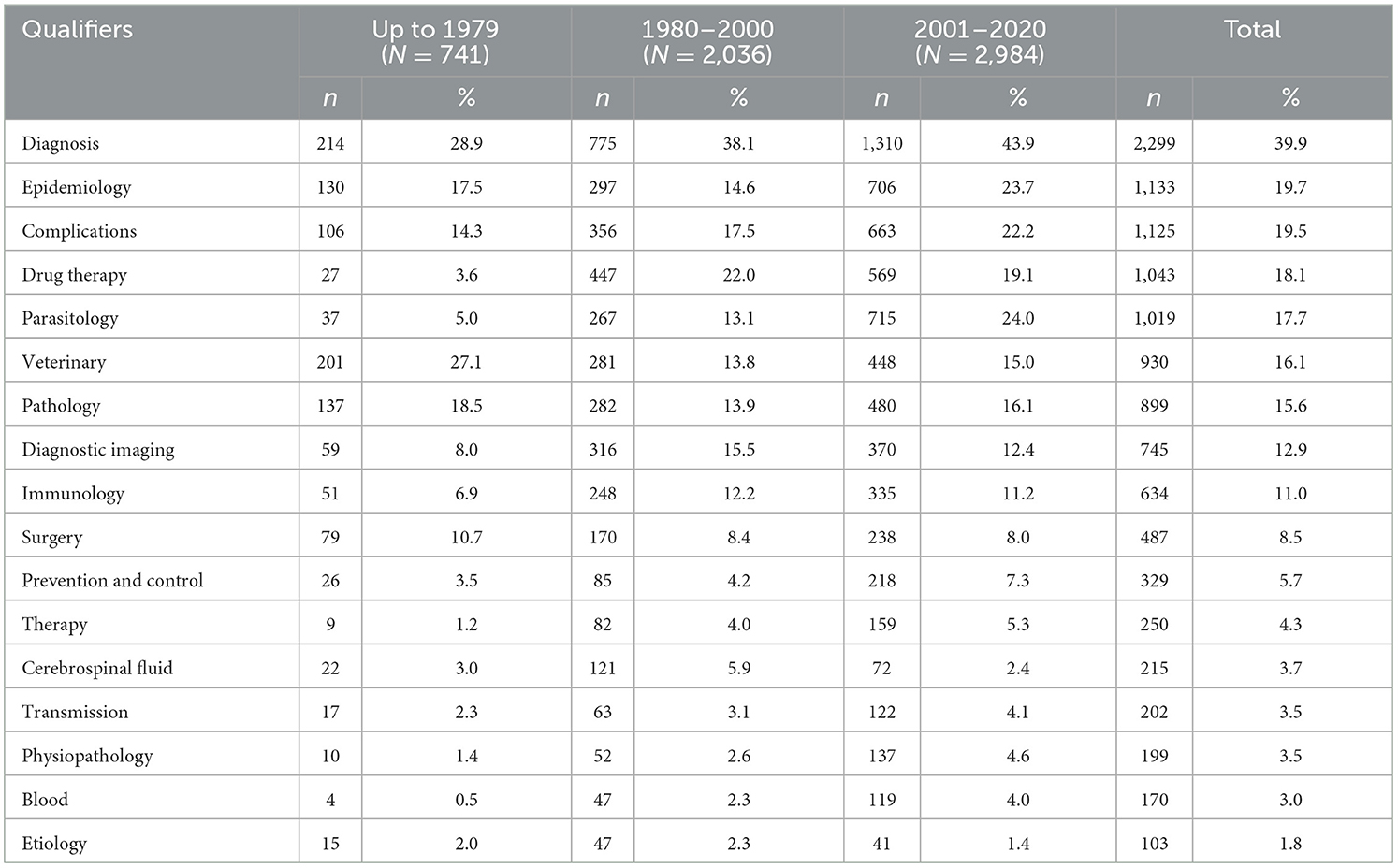
Table 6. Qualifiers accompanying the MeSH descriptors for cysticercosis and neurocysticercosis on documents indexed in MEDLINE.
The most prominent descriptors related to diagnostic procedures and techniques were the diagnostic imaging procedures “tomography, x-ray computed” (n = 961), “magnetic resonance imaging” (n = 823) and, less frequently, “radiography” (n = 186) and “ultrasonography” (n = 86). Different methods and procedures for diagnosing diseases of the nervous system are also present, such as “electroencephalography” (n = 113) and “cerebral ventriculography” (n = 57).
Although “adult” (n = 2,315) is the main descriptor in relation to age groups, research linked to “adolescent” (n = 1,214) and “child” (n = 1,128) also has a notable presence (Table 7).
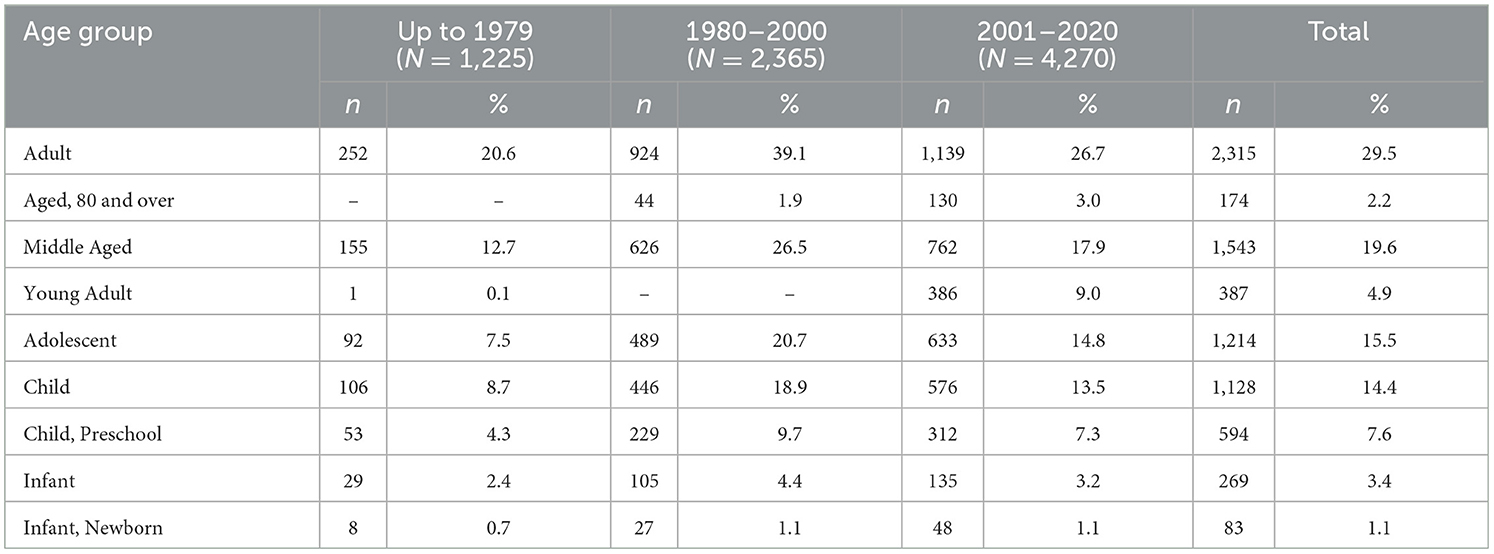
Table 7. MeSH descriptors related to age groups, assigned to scientific publications on cysticercosis and neurocysticercosis, indexed in MEDLINE.
Figure 3 presents the network of thematic clusters generated from the co-occurrence of the MeSH terms. Research interest is concentrated in three spheres:
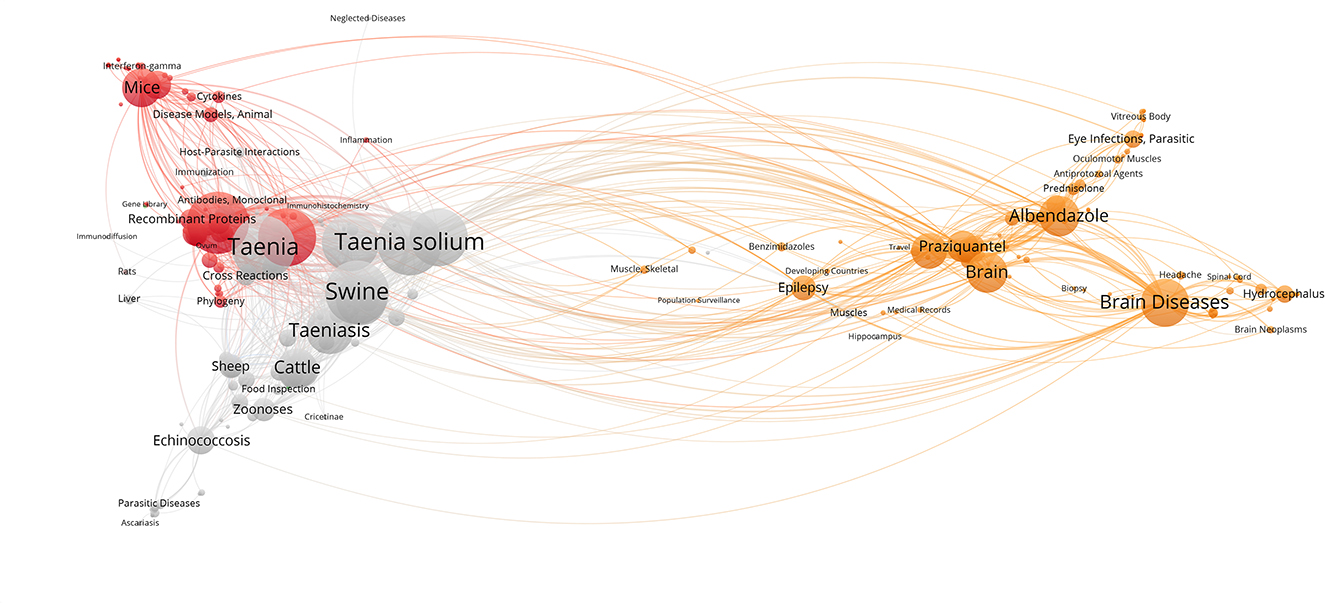
Figure 3. Thematic clusters generated from the MeSH descriptors assigned to the documents published on cysticercosis and neurocysticercosis and indexed in MEDLINE.
- Basic research. This cluster addresses the development of animal models, DNA sequencing, immunization, and vaccine development, among other aspects.
- Parasitism, animal health and zoonoses. Parasitic diseases linked to different animal species stand out in this cluster (echinococcosis, toxoplasmosis, trichinellosis, schistosomiasis, etc.). The possibility that the pathogens causing them are transmitted to humans (zoonosis) through food or inadequate hygienic conditions is reflected through different terms (e.g., health education, food health, rural health).
- Diagnosis and therapeutic approach. Within this area, brain diseases and eye diseases show specific development. There is a well-defined research cluster focusing on diseases that affect the brain, including epilepsy, hydrocephalus, brain neoplasms, gliomas, and meningitis. This cluster also encompasses associated symptoms and clinical manifestations, such as headache, intracranial pressure, and granulomas; and general descriptions of diagnostic methods, treatments (anti-inflammatory, antiparasitic, antiprotozoal or anthelmintic agents), and compounds (albenzadole, praziquantel, prednisone, prednisolone). Several eye diseases also stand out for the research interest they attract, including parasitic, conjunctive, retinal and orbital eye diseases.
Supplementary Annex II contains the list of the main MeSH terms (assigned to > 99 documents).
The evolution of scientific output on cysticercosis and neurocysticercosis shows a moderate but sustained increase in productivity in comparison to the study by Delgado et al. (16), who analyzed the publications indexed in MEDLINE from 1965 to 1995. Our results show that Latin American countries, together with the USA and Asian countries like India, China, Japan, and South Korea, lead research on the topic, while African countries are less present in the literature. These findings reflect a shift in scientific production since Delgado et al. (16) published their analysis, in which Asian and African researchers and institutions of reference were absent.
The scientific production on cysticercosis and neurocysticercosis in the present study (147–197 documents/year between 2001 and 2010 and over 200 documents per year since 2010) is significantly lower than that observed for other NTDs in MEDLINE, for example Chagas disease, with values above 500 documents per year since 2000 (17), or leishmaniasis, whose scientific output has been above 800 documents per year since the same date (18). There also seems to be more research activity on chikungunya, as the scientific output of the most recent year (2014) reported in the study by Vera-Polania et al. (19) was over 300 papers. This lower scientific production in global terms, together with other factors observed in this study, such as the lack of participation in research activities in many endemic countries or the fact that the damage associated with cysticercosis assessed using DALYs is higher than many other NTDs in recent published reports, including Chagas disease and leishmaniasis used as comparative references, highlights the relevance of promoting research in the field analyzed (20).
Research production on cysticercosis and neurocysticercosis is much greater in the USA than in Europe. The reasons for this difference reside in various factors, particularly the flow of immigrants from endemic countries to the USA (21, 22), which has led to the spread of neurocysticercosis to this country and its local transmission, making it a prominent public health problem. Researchers have highlighted the relevance of screening high-risk patients, prompt care for those infected, and transmission control, while the greater access to health and diagnostic systems in the USA compared to endemic countries also contributes to the research interest here.
The endemicity of the infection in the Indian subcontinent and in a large part of Latin America, areas where there is close contact with domestic animal hosts and less hygienic conditions (23–26), helps to explain the outstanding scientific production in countries such as India, Mexico, Brazil, and Peru, where there are prominent reference centers for research on the disease and its associated conditions, such as epilepsy (27, 28). In this regard, some studies have pointed out that infection is responsible for 30% of all epilepsies in developing countries (27, 28). On the other hand, other endemic countries in Latin America show little to no scientific production: no documents were authored by researchers in Paraguay, while the presence of other countries such as Haiti, the Dominican Republic, Nicaragua, and El Salvador is negligible. This is also the case for endemic countries in Africa: institutional affiliations in Togo, Rwanda, Gambia, the Republic of the Congo, Ghana, and Namibia are very limited, and no publications were identified with authors in Angola, Chad, South Sudan, Guinea-Bissau, or Cape Verde. The null participation in research on cysticercosis and neurocysticercosis also extends to “suspected endemic” countries (Bangladesh, Guinea, Sierra Leone, Lesotho, Equatorial Guinea, Eswatini, and Timor-Leste) or countries with “possible transmission” according to the WHO (Eritrea, Somalia and Turkmenistan). Furthermore, many other endemic countries have only made limited scientific contributions to the international literature (just 9 of the 55 endemic countries have published more than 100 papers). It is therefore essential to promote economic investments, structures, and collaborative initiatives to foster research in the geographical areas and low- to middle-income countries where the disease has the largest impact. Such initiatives are relevant both in the case of cysticercosis and neurocysticercosis, analyzed in the present study, and more broadly for the rest of the NTDs (29, 30).
The case of Peru is paradigmatic in terms of the development of biomedical research on cysticercosis and neurocysticercosis. There, policies aimed at promoting training programs and international alliances have nurtured the country's research culture and attracted international funding, which has resulted in a significant increase in scientific productivity, particularly on topics such as the most prevalent infectious diseases or endemic NTDs that affect the country (31).
Scientific collaboration has emerged as a crucial mechanism for promoting research and particularly for generating synergies between countries with more and less economic development. This has also been the experience in relation to other endemic as HIV infection or emerging NTDs as Chagas disease, that are difficult to control in countries with less socioeconomic development (12, 32, 33). In countries with lower income levels, smaller populations, and scientific systems with less capacity, including Peru but also Ecuador, Tanzania, Kenya and Thailand, the high level of international collaboration (65% to 93% of the documents on cysticercosis and neurocysticercosis) contrasts with the lower levels observed in larger countries like Mexico, Brazil, and India (< 31%). While international collaboration is positive, the fact that few researchers from low- to middle-income countries (e.g., Peru or Tanzania) take on leadership roles as first or corresponding authors shows the need to promote balance in research development, which involves strengthening the national scientific systems and scientific excellence in these settings (31, 34).
Research on cysticercosis and neurocysticercosis in humans is dominated by case studies (27.4% of publications vs. only 3.1% of clinical studies or 0.8% of systematic reviews). This can be explained by the fact that the disease has unusual manifestations, presents an atypical course, and requires differential treatments that need to be clearly communicated to the scientific community for clinical practice (35). Moreover, diagnosing neurocysticercosis is complex, especially in many endemic areas that lack the necessary diagnostic imaging equipment (36). For all these reasons, despite the fact that case studies are located at the bottom of the hierarchy of scientific evidence (37), this study design has outstanding relevance for diagnosis and clinical practice, as also determined in relation to other rare diseases and NTDs (38).
The fact that cysticercosis is a zoonotic disease, transmissible between animals and humans, reinforces the relevance of the One Health approach. This research paradigm integrates animal, human, and environmental health, and it favors mechanisms that allow the translation of evidence to health policies and practices (39). The impact of this approach on cysticercosis research is evident: the proportion of documents assigned with descriptors for both “human” and “animal” has increased from just 13% of those published before 1979 to 36% from the year 2000 onward. Furthermore, there is a notable presence of journals focused on tropical medicine in relation to human health (American Journal of Tropical Medicine and Hygiene); parasitology journals that cover human and animal health (particularly in the tropics and sub-tropics), the control of parasitic diseases, and the relationship between the host and the parasite (Acta Tropica or Parasitology Research); and veterinary journals, more focused on animal health, but whose research is crucial for global health (Veterinary Parasitology).
The thematic analysis enabled the identification and characterization of the main lines of inquiry that have shaped the development of research on cysticercosis and neurocysticercosis:
- Basic research and animal models allow a better understanding of the pathophysiology of the disease, determining the processes that take place during the development of the infection in the different species of animals and their immune response. As described in the literature, basic research in animals can contribute to determining risk factors and identifying specific biomarkers that signal the development of the disease or inform the development of vaccines (40, 41).
- The transmission models of the T. solium parasite and the animal health control measures represent tools for controlling the disease in humans, as reflected through different works that address food control, education, and health in rural areas, particularly in countries with low resources where this parasitism has a significant economic impact (42).
- Research on the disease in humans, its prognosis and therapeutic approach, constitute the third main research focus on cysticercosis and neurocysticercosis. Within this area, in relation to diagnosis, which remains the primary reference for research (16), research on brain diseases and parasitic eye diseases show specific development.
The fact that neurocysticercosis is one of the most common causes of epilepsy and other neurological manifestations, especially in endemic areas, is reflected in clinical research on brain diseases (9, 10, 43). The analysis also shows the relevance of the manifestations of cysticercosis outside the central nervous system, through ophthalmological involvement of the eyelids, the conjunctiva, and the anterior chamber (44), or the co-occurrence of intracranial and intraocular cysticercosis as a common phenomenon in clinical practice. Indeed, numerous cases of unusual presentations of cysticercosis in the eyes have also been published. Other organs that can be affected are the subcutaneous tissue, skeletal muscles, lungs, heart, thyroid, and pancreas (45).
Regarding the therapeutic approach to cysticercosis and neurocysticercosis, Singhi and Saini (46) highlighted the lack of a gold standard test to diagnose neurocysticercosis and the incipient nature of the management recommendations. Anthelmintics (drugs to treat worm infections) such as albendazole and praziquantel have been used to treat central nervous system lesions in neurocysticercosis, as have cysticides, although there is no clearly established clinical evidence (47). Thus, it is crucial to perform clinical trials that generate knowledge on adequate treatments (48, 49). Other aspects of treatment in humans relate to antiepileptic drugs to treat seizures (41) and the use of steroids, their indication, and duration (50, 51).
The main limitations of this study include the use of the MEDLINE database as a source of bibliographic data, which may have led to the omission of relevant publications in the analysis, particularly those published in endemic countries in languages other than English and literature related to psychosocial aspects. As an example, the same search carried out in the databases of the Virtual Health Library (VHL, https://bvsalud.org/en/), excluding MEDLINE, identifies 1,438 (18.09%) additional documents, with Spanish (n = 555, 6.98%), Portuguese (n = 298, 3.75%), Korean (n = 128, 1.61%) and Chinese (n = 77, 0.97%) standing out. Another relevant aspect to keep in mind is that the MeSH thesaurus includes the term coenurosis as a synonym for cysticercosis. This larval form, although present in members of the genus Taenia, is unrelated to T. solium or cysticercosis. This circumstance has had a limited incidence in the present analysis, may be relevant for future studies if these entities are not differentiated in the MeSH thesaurus. In addition, there are limitations inherent to the use of bibliometrics as a research methodology, which offers a quantitative vision of the development of research, as reflected in the form of publications and particularly scientific journals. Future lines of research can analyze the participation of research groups in publications on cysticercosis/neurocysticercosis and their impact.
The generation of knowledge about cysticercosis as a neglected tropical disease presents different features from other areas of research. Case studies are the most prominent study design used, and some endemic countries are among the most prolific producers of research, in many cases overtaking the countries with far more established scientific systems. Nevertheless, authors from many other countries—especially those with less economic development—show negligible levels of participation. The relevance of comprehensive approaches to research (animal and human health) is also noteworthy. Studies that provide higher levels of scientific evidence should be promoted, and the participation and leadership of researchers from all endemic countries should be encouraged.
The raw data supporting the conclusions of this article will be made available by the authors, without undue reservation.
J-MR-R and GG-A planned and designed the project, performed the analysis of data, and write original draft. NS, LS, and IB-R performed the interpretation of data. All authors reviewed the manuscript.
This study was financed in part through a grant from the Spanish Ministry of Universities, in Modality A, Research stays by senior professors and researchers in foreign centers, 2021 (No: PRX21/00396).
The authors declare that the research was conducted in the absence of any commercial or financial relationships that could be construed as a potential conflict of interest.
All claims expressed in this article are solely those of the authors and do not necessarily represent those of their affiliated organizations, or those of the publisher, the editors and the reviewers. Any product that may be evaluated in this article, or claim that may be made by its manufacturer, is not guaranteed or endorsed by the publisher.
The Supplementary Material for this article can be found online at: https://www.frontiersin.org/articles/10.3389/fvets.2023.1156834/full#supplementary-material
1. Engels D, Zhou X-N. Neglected tropical diseases: an effective global response to local poverty-related disease priorities. Infect Dis Poverty. (2020) 9:10. doi: 10.1186/s40249-020-0630-9
2. Molyneux DH, Savioli L, Engels D. Neglected tropical diseases: progress towards addressing the chronic pandemic. Lancet. (2017) 389:312–25. doi: 10.1016/S0140-6736(16)30171-4
3. World Health Organization. (2020). Ending the Neglect to Attain the Sustainable Development Goals A Road Map for Neglected Tropical Diseases 2021–2030. Geneva: WHO.
4. Boelaert M, NIDIAG Consortium. Clinical research on neglected tropical diseases: challenges and solutions. PLoS Negl Trop Dis. (2016) 10:e0004853. doi: 10.1371/journal.pntd.0004853
5. Fonseca BP, Albuquerque PC, Zicker F. Neglected tropical diseases in Brazil: lack of correlation between disease burden, research funding and output. Trop Med Int Health. (2020) 25:1373–84. doi: 10.1111/tmi.13478
6. Gripper LB, Welburn SC. Neurocysticercosis infection and disease: a review. Acta Trop. (2017) 166:218–24. doi: 10.1016/j.actatropica.2016.11.015
7. Larkins A, Bruce M, Di Bari C, Devleesschauwer B, Pigott DM, Ash A, et al. A scoping review of burden of disease studies estimating disability-adjusted life years due to T. solium. PLoS Negl Trop Dis. (2022) 16:e0010567. doi: 10.1371/journal.pntd.0010567
8. Torgerson PR, Devleesschauwer B, Praet N, Speybroeck N, Willingham AL, Kasuga F, et al. World Health Organization estimates of the global and regional disease burden of 11 foodborne parasitic diseases, 2010: a data synthesis. PLoS Med. (2015) 12:e1001920. doi: 10.1371/journal.pmed.1001920
9. Bustos J, Gonzales I, Saavedra H, Handali S, Garcia HH, Cysticercosis Working Group in Peru. Neurocysticercosis. A frequent cause of seizures, epilepsy, and other neurological morbidity in most of the world. J Neurol Sci. (2021) 427:117527. doi: 10.1016/j.jns.2021.117527
10. Debacq G, Moyano LM, Garcia HH, Boumediene F, Marin B, Ngoungou EB, et al. Systematic review and meta-analysis estimating association of cysticercosis and neurocysticercosis with epilepsy. PLoS Negl Trop Dis. (2017) 11:e0005153. doi: 10.1371/journal.pntd.0005153
11. Fakhar M, Keighobadi M, Hezarjaribi HZ, Montazeri M, Banimostafavi ES, Sayyadi S, et al. Two decades of echinococcosis/hydatidosis research: Bibliometric analysis based on the web of science core collection databases (2000–2019). Food Waterborne Parasitol. (2021) 25:e00137. doi: 10.1016/j.fawpar.2021.e00137
12. González-Alcaide G, Salinas A, Ramos JM. Scientometrics analysis of research activity and collaboration patterns in Chagas cardiomyopathy. PLoS Negl Trop Dis. (2018) 12:e0006602. doi: 10.1371/journal.pntd.0006602
13. Hassan MD, Castanha RCG, Wolfram D. Scientometric analysis of global trypanosomiasis research: 1988–2017. J Infect Public Health. (2020) 13:514–20. doi: 10.1016/j.jiph.2019.10.006
14. Ram S. A bibliometric profile of lymphatic filariasis research in India. J Vector Borne Dis. (2015) 52:73–8.
15. Sánchez-Marqués R, Mas-Coma S, Salas-Coronas J, Boissier J, Bargues MD. Research on schistosomiasis in the era of the COVID-19 pandemic: a bibliometric analysis. Int J Environ Res Public Health. (2022) 19:8051. doi: 10.3390/ijerph19138051
16. Delgado H, Calderón-Albor J, Flores-Macías D, Martín Galván J, Flisser A. Cisticercosis: productividad científica medida por medio de un análisis de la literatura publicada entre 1965 y 1995. Gac Med Mex. (1996) 132:63–70.
17. Ramos JM, González Alcaide G, Gascón J, Gutiérrez F. Mapping of Chagas disease research: analysis of publications in the period between 1940 and 2009. Rev Soc Bras Med Trop. (2011) 44:708–16. doi: 10.1590/S0037-86822011005000060
18. Ramos JM, González Alcaide G, Bolaños Pizarro M. Bibliometric analysis of leishmaniasis research in Medline (1945–2010). Parasit Vect. (2013) 6:55. doi: 10.1186/1756-3305-6-55
19. Vera-Polania F, Muñoz-Urbano M, Bañol-Giraldo AM, Jimenez-Rincón M, Granados-Álvarez S, Rodriguez-Morales AJ, et al. Bibliometric assessment of scientific production of literature on chikungunya. J Infect Public Health. (2015) 8:386–8. doi: 10.1016/j.jiph.2015.03.006
21. Serpa JA, White AC. Neurocysticercosis in the United States. Pathog Glob Health. (2012) 106:256–60. doi: 10.1179/2047773212Y.0000000028
22. Spallone A, Woroch L, Sweeney K, Seidman R, Marcos LA. The burden of neurocysticercosis at a single New York hospital. J Pathog. (2020) 2020:8174240. doi: 10.1155/2020/8174240
23. Bhattarai R, Budke CM, Carabin H, Proaño JV, Flores-Rivera J, Corona T, et al. Estimating the non-monetary burden of neurocysticercosis in Mexico. PLoS Negl Trop Dis. (2012) 6:e1521. doi: 10.1371/journal.pntd.0001521
24. Martins-Melo FR, Ramos AN, Cavalcanti MG, Alencar CH, Heukelbach J. Reprint of “Neurocysticercosis-related mortality in Brazil, 2000–2011: epidemiology of a neglected neurologic cause of death”. Acta Trop. (2017) 165:170–8. doi: 10.1016/j.actatropica.2016.11.009
25. Rajkotia Y, Lescano AG, Gilman RH, Cornejo C, Garcia HH, Cysticercosis Working Group of Peru. Economic burden of neurocysticercosis: results from Peru. Trans R Soc Trop Med Hyg. (2007) 101:840–6. doi: 10.1016/j.trstmh.2007.03.008
26. Singh SP, Singh BB, Kalambhe DG, Pathak D, Aulakh RS, Dhand NK, et al. Prevalence and distribution of T. solium cysticercosis in naturally infected pigs in Punjab, India. PLoS Negl Trop Dis. (2018) 12:e0006960. doi: 10.1371/journal.pntd.0006960
27. Rubio C, Luna R, Ibarra-Velasco M, Lee A. Epilepsy: a bibliometric analysis (1968–2020) of the Instituto Nacional de Neurología y Neurocirugía “Manuel Velasco Suárez” in Mexico. Epilepsy Behav. (2021) 115:107676. doi: 10.1016/j.yebeh.2020.107676
28. Rubio C, Rodríguez-Quintero P, Fleury A, Suástegui-Román RA, Bowles B, González-Garibay G, et al. Neurocysticercosis research in Mexico: a bibliometric analysis of the Instituto Nacional de Neurología y Neurocirugía Manuel Velasco Suárez. Front Trop Dis. (2022) 3:975165. doi: 10.3389/fitd.2022.975165
29. Fontecha G, Sánchez A, Ortiz B. Publication trends in neglected tropical diseases of Latin America and the Caribbean: a bibliometric analysis. Pathogens. (2021) 10:356. doi: 10.3390/pathogens10030356
30. Sweileh WM. Contribution of researchers in Arab countries to scientific publications on neglected tropical diseases (1971–2020). Trop Dis Travel Med Vacc. (2022) 8:14. doi: 10.1186/s40794-022-00173-7
31. Belter CW, Garcia PK, Livinski AA, Leon-Velarde F, Weymouth KH, Glass RI, et al. The catalytic role of a research university and international partnerships in building research capacity in Peru: a bibliometric analysis. PLoS Negl Trop Dis. (2019) 13:e0007483. doi: 10.1371/journal.pntd.0007483
32. González-Alcaide G, Menchi-Elanzi M, Nacarapa E, Ramos-Rincón JM. HIV/AIDS research in Africa and the Middle East: participation and equity in North-South collaborations and relationships. Global Health. (2020) 16:83. doi: 10.1186/s12992-020-00609-9
33. Morán-Mariños C, Pacheco-Mendoza J, Metcalf T, de la Cruz Ramirez W, Alva-Diaz C. Collaborative scientific production of epilepsy in Latin America from 1989 to 2018: a bibliometric analysis. Heliyon. (2020) 6:e5493. doi: 10.1016/j.heliyon.2020.e05493
34. González-Alcaide G, Park J, Huamaní C, Ramos JM. Dominance and leadership in research activities: collaboration between countries of differing human development is reflected through authorship order and designation as corresponding authors in scientific publications. PLoS ONE. (2017) 12:e0182513. doi: 10.1371/journal.pone.0182513
35. Nery TB, Gelape CL, Passaglia LG, Carmo GALD. Cardiac cysticercosis: a rare cause of myocardial infarction. J Thorac Cardiovasc Surg. (2018) 155:e155–8. doi: 10.1016/j.jtcvs.2017.10.058
36. Butala C, Brook TM, Majekodunmi AO, Welburn SC. Neurocysticercosis: current perspectives on diagnosis and management. Front Vet Sci. (2021) 8:615703. doi: 10.3389/fvets.2021.615703
37. DiCenso A, Bayley L, Haynes RB. ACP Journal Club. Editorial: accessing preappraised evidence: fine-tuning the 5S model into a 6S model. Ann Intern Med. (2009) 151:JC3–2. doi: 10.7326/0003-4819-151-6-200909150-02002
38. González-Alcaide G, Peris J, Ramos JM. Areas of research and clinical approaches to the study of liver abscess. World J Gastroenterol. (2017) 23:357–65. doi: 10.3748/wjg.v23.i2.357
39. Graham ID, Kothari A, McCutcheon C, Integrated Knowledge Translation Research Network Project Leads. Moving knowledge into action for more effective practice, programmes and policy: protocol for a research programme on integrated knowledge translation. Implement Sci. (2018) 13:22. doi: 10.1186/s13012-017-0700-y
40. Alroy KA, Arroyo G, Gilman RH, Gonzales-Gustavson E, Gallegos L, Gavidia CM, et al. Carotid T. solium oncosphere infection: a novel porcine neurocysticercosis model. Am J Trop Med Hyg. (2018) 99:380–7. doi: 10.4269/ajtmh.17-0912
41. Sitali MC, Schmidt V, Mwenda R, Sikasunge CS, Mwape KE, Simuunza MC, et al. Experimental animal models and their use in understanding cysticercosis: a systematic review. PLoS ONE. (2022) 17:e0271232. doi: 10.1371/journal.pone.0271232
42. Kayuni EN. Socio-economic and health costs of porcine/human cysticercosis, neurocysticercosis and epilepsy to small-scale pig producers in Tanzania. Bull Natl Res Cent. (2021) 45:217. doi: 10.1186/s42269-021-00676-x
43. de Oliveira RS, Viana DC, Colli BO, Rajshekhar V, Salomão JFM. Pediatric neurocysticercosis. Childs Nerv Syst. (2018) 34:1957–65. doi: 10.1007/s00381-018-3889-4
44. Jain RS, Kumar S, Bhana I, Agarwal R. Ocular cysticercosis with vitreous hemorrhage: a rare complication of a common disease. Springerplus. (2015) 4:217. doi: 10.1186/s40064-015-1006-7
45. Dsilva G, Kulkarni V, Aher S. An uncommon manifestation of a common disease. Ann Parasitol. (2017) 63:357–60. doi: 10.17420/ap6304.124
46. Singhi P, Saini AG. Pediatric neurocysticercosis: current challenges and future prospects. Pediatric Health Med Ther. (2016) 7:5–16. doi: 10.2147/PHMT.S79058
47. O'Neal SE, Pray IW, Vilchez P, Gamboa R, Muro C, Moyano LM, et al. Geographically targeted interventions vs. mass drug administration to control T. solium cysticercosis, Peru. Emerg Infect Dis. (2021) 27:2389–98. doi: 10.3201/eid2709.203349
48. Garcia HH, Gonzales I, Lescano AG, Bustos JA, Zimic M, Escalante D, et al. Efficacy of combined antiparasitic therapy with praziquantel and albendazole for neurocysticercosis: a double-blind, randomised controlled trial. Lancet Infect Dis. (2014) 14:687–95. doi: 10.1016/S1473-3099(14)70779-0
49. Monk EJM, Abba K, Ranganathan LN. Anthelmintics for people with neurocysticercosis. Cochrane Database Syst Rev. (2021) 6:CD000215. doi: 10.1002/14651858.CD000215.pub5
50. Thang TD, Phuc TQ, Thanh DT, Thieu NQ, Tho TH, Loi CB, et al. Efficacy and safety of praziquantel in the treatment of neurocysticercosis in Vietnam. Trop Biomed. (2022) 39:462–6. doi: 10.47665/tb.39.3.018
Keywords: cysticercosis, neurocysticercosis, Tenia solium, animals, human, bibliometrics
Citation: Gonzalez-Alcaide G, Sosa N, Shevy L, Belinchon-Romero I and Ramos-Rincon J-M (2023) Global research on cysticercosis and neurocysticercosis: A bibliometric analysis. Front. Vet. Sci. 10:1156834. doi: 10.3389/fvets.2023.1156834
Received: 01 February 2023; Accepted: 22 March 2023;
Published: 11 April 2023.
Edited by:
Yukifumi Nawa, Khon Kaen University, ThailandReviewed by:
Nariaki Nonaka, Hokkaido University, JapanCopyright © 2023 Gonzalez-Alcaide, Sosa, Shevy, Belinchon-Romero and Ramos-Rincon. This is an open-access article distributed under the terms of the Creative Commons Attribution License (CC BY). The use, distribution or reproduction in other forums is permitted, provided the original author(s) and the copyright owner(s) are credited and that the original publication in this journal is cited, in accordance with accepted academic practice. No use, distribution or reproduction is permitted which does not comply with these terms.
*Correspondence: Jose-Manuel Ramos-Rincon, am9zZS5yYW1vc3JAdW1oLmVz
†ORCID: Gregorio Gonzalez-Alcaide orcid.org/0000-0003-3853-5222
Nestor Sosa orcid.org/0000-0002-5244-5437
Laura Shevy orcid.org/0000-0002-5907-9564
Isabel Belinchon-Romero orcid.org/0000-0002-6007-7320
Jose-Manuel Ramos-Rincon orcid.org/0000-0002-6501-9867
Disclaimer: All claims expressed in this article are solely those of the authors and do not necessarily represent those of their affiliated organizations, or those of the publisher, the editors and the reviewers. Any product that may be evaluated in this article or claim that may be made by its manufacturer is not guaranteed or endorsed by the publisher.
Research integrity at Frontiers

Learn more about the work of our research integrity team to safeguard the quality of each article we publish.